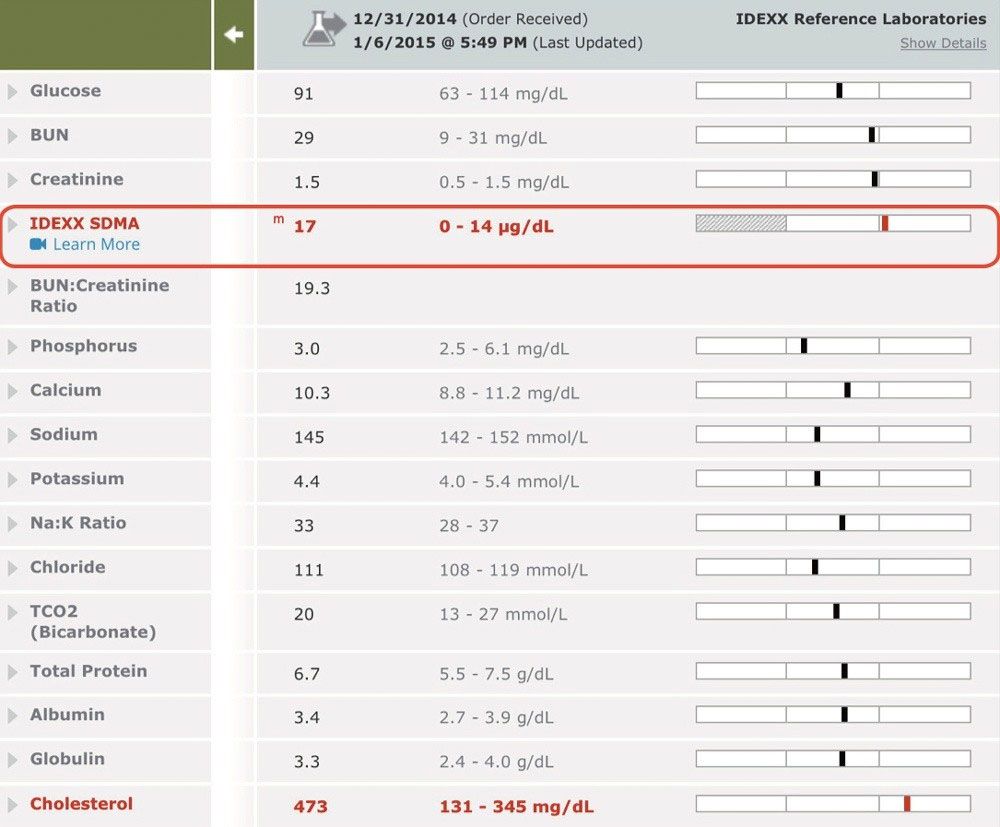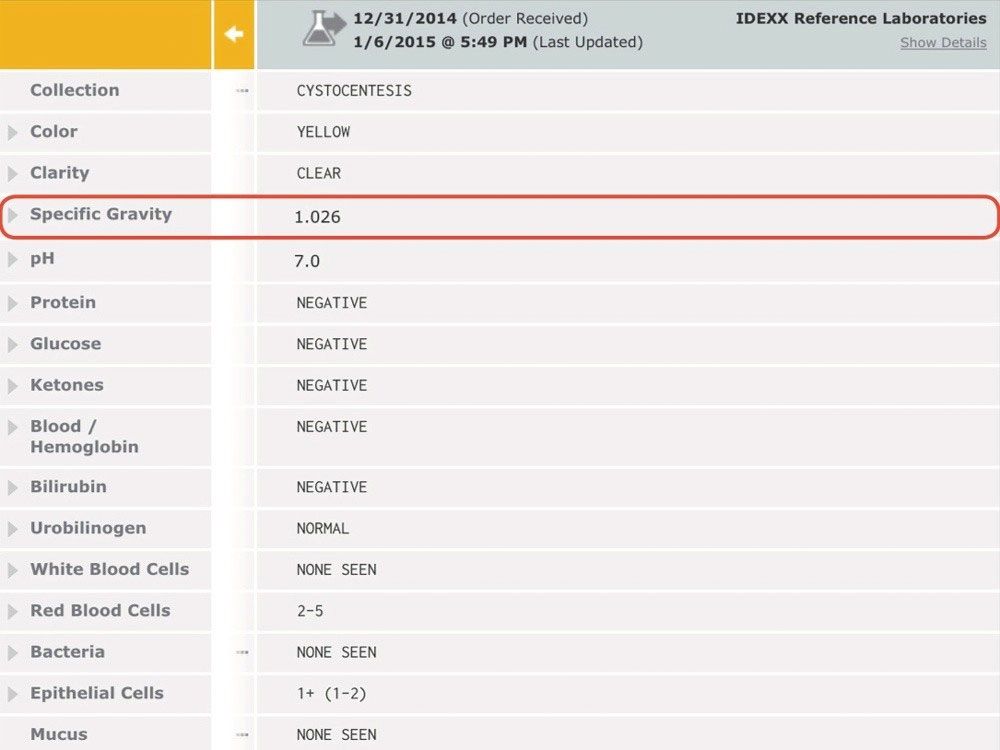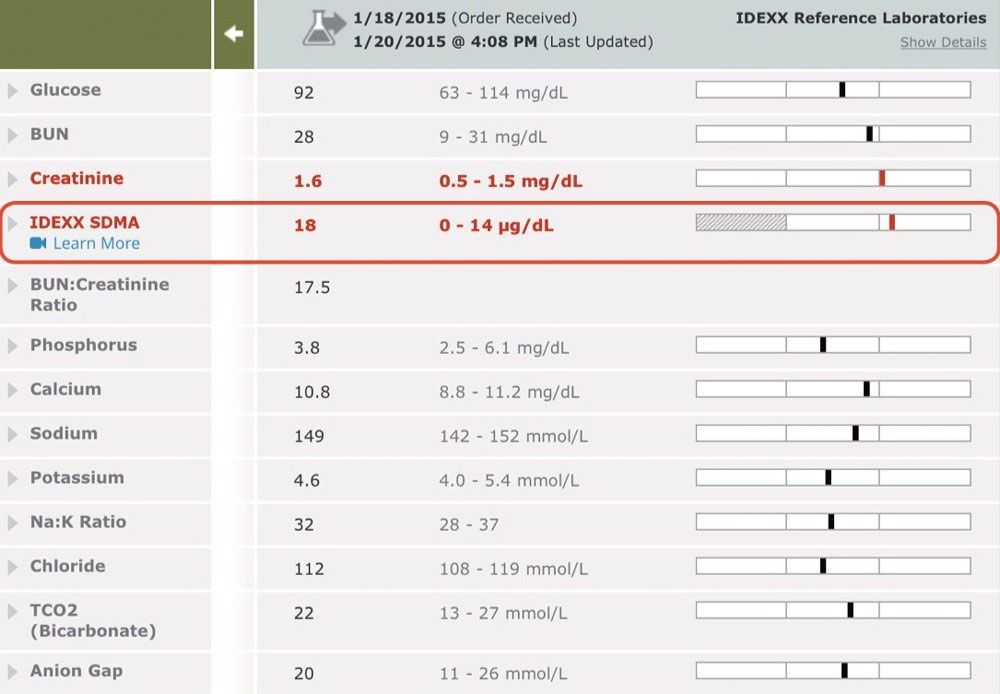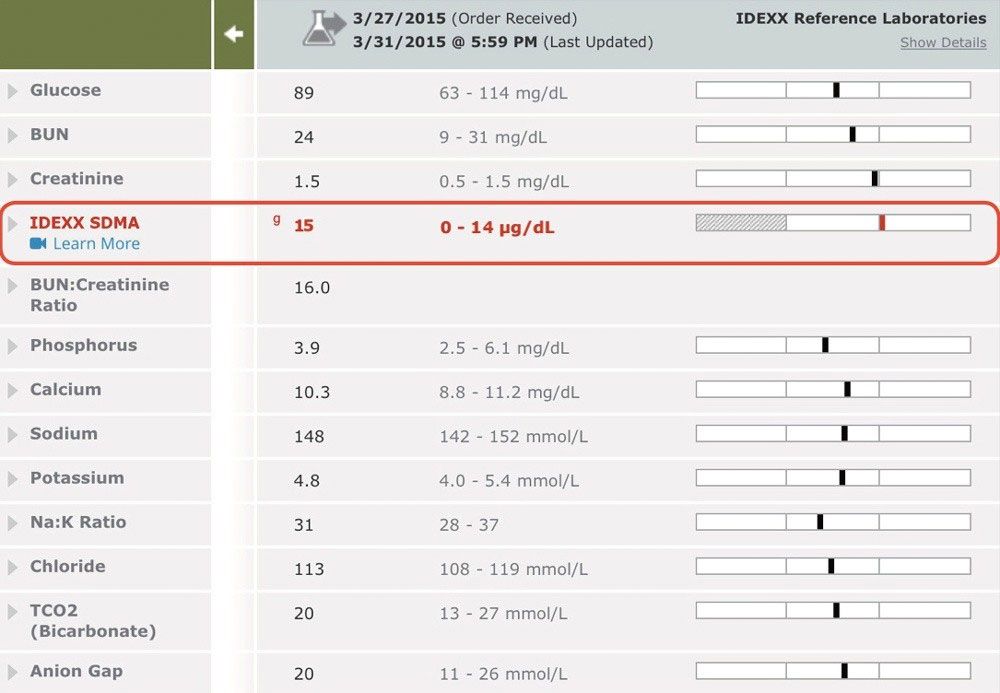IDEXX SDMA
SDMA Case Study: Scarlet
Increased SDMA leads to discovery of early chronic kidney disease in a dog during a preventive care visit

Background information
Name: Scarlet
Age: 5 years
Breed: Golden retriever
Gender: Female
Presenting reason
Scarlet was brought in for her annual checkup and vaccines.
History
Scarlet’s owners shared that she had not been acting like herself the past few weeks. She had a couple of urinary tract infections in the past, though she had not recently been showing those types of signs. She had been less energetic, but appetite and drinking had seemed normal as far as they had been able to tell.
Physical examination
Scarlet was bright, alert and responsive (BAR), appeared well-hydrated, and had good body condition with stable weight since last visit.
Diagnostic plan
Complete blood count (CBC); chemistry panel, including the IDEXX SDMA Test and electrolytes; complete urinalysis; and total T4 were recommended.
Laboratory findings
- Scarlet’s CBC was unremarkable, though her other blood and urine diagnostics identified some areas of concern.
- She had an increased SDMA* of 17 μg/dL (0–14 μg/dL) and a low urine specific gravity of 1.026. Her creatinine was within the reference interval at 1.5 mg/dL.
- Her total T4 and free T4 were both within reference intervals but were low normal.
Treatment plan and follow-up
-
Scarlet was started on L-thyroxine for treatment of presumptive hypothyroidism.
-
A recheck was scheduled in 2–3 weeks for follow-up CBC, chemistry, total T4 and complete urinalysis.
-
Additional test considerations included diagnostic imaging of her kidneys and associated structures as well as evaluation of urine protein: creatinine (UPC) ratio and blood pressure.
2-week recheck: The pet owner reported that Scarlet seemed to be more active. Her total T4 result was well within normal limits, her SDMA remained increased at 18 μg/dL and her creatinine remained within the reference interval. Her urine specific gravity remained low at 1.027.
Action plan and results
-
Because of the persistent SDMA elevation, an ultrasound on Scarlet’s kidneys and associated structures was scheduled.
-
The ultrasound showed the left kidney was somewhat rounded and mildly irregular with some mild dilation of the renal pelvis with changes suspected to be the result of prior kidney infections.
-
A urine culture was negative; the UPC was 0.0 and her average systolic blood pressure was normal at 140 mm Hg.
-
Scarlet continued to show a persistence in SDMA elevation and abnormal kidney imaging. Following the International Renal Interest Society (IRIS) Chronic Kidney Disease (CKD) Staging Guidelines, these findings supported IRIS CKD Stage 2 disease, which was substaged as normotensive and nonproteinuric.
-
Scarlet’s treatment plan included initiating a kidney therapeutic diet and continuing with her L-thyroxine and access to fresh water sources at home, along with more regular appointments to monitor her kidney health. A 3-month recheck was scheduled to perform CBC, chemistry panel, total T4 and complete urinalysis.
3-month recheck: Scarlet was reportedly doing well at home. Her total T4 levels remained well within the reference interval, and CBC was unremarkable. Her SDMA was 15 μg/dL, and her creatinine remained within normal limits. Her urine specific gravity remained low at 1.027.
6-month recheck: Given Scarlet’s activity level, improving diagnostics and reports from the pet owner, twice yearly checkups were recommended moving forward. At that time, Scarlet’s SDMA remained at 15 μg/dL, her creatinine was still within normal limits and her urine specific gravity was at 1.026.
Patient reports
Chemistry reports (December 31)

Urinalysis reports (December 31)

Total T4 and Free T4 (December 31)

Chemistry (January 18)

Total T4 (January 18)

Chemistry (March 27)

Discussion
SDMA is a more reliable biomarker for kidney disease than creatinine,1–5 and it helped to define a thorough medical follow-up plan for Scarlet, even at early stages of kidney changes.
Early intervention and support of Scarlet’s kidney function with a kidney supportive diet helped lead to stabilised SDMA results in her follow-up rechecks. Evidence shows that SDMA can be relied upon for early detection of kidney disease and that dietary intervention prior to an elevation of creatinine can have health benefits for the kidneys.1,2
*Symmetric dimethylarginine.
References
- Hall JA, Yerramilli M, Obare E, Yerramilli M, Yu S, Jewell DE. Comparison of serum concentrations of symmetric dimethylarginine and creatinine as kidney function biomarkers in healthy geriatric cats fed reduced-protein foods enriched with fish oil, L-carnitine and medium-chain triglycerides. Vet J. 2014;202(3):588-596.
- Hall JA, Yerramilli M, Obare E, Yerramilli M, Melendez LD, Jewell DE. Relationship between lean body mass and serum renal biomarkers in healthy dogs. J Vet Intern Med. 2015;29(3):808-814.
- Nabity MB, Lees GE, Boggess M, et al. Symmetric dimethylarginine assay validation, stability and evaluation as a marker for early detection of chronic kidney disease in dogs. J Vet Intern Med. 2015;29(4):1036-1044.
- Hall JA, Yerramilli M, Obare E, Yerramilli M, Jewell DE. Comparison of serum concentrations of symmetric dimethylarginine and creatinine as kidney function biomarkers in cats with chronic kidney disease. J Vet Intern Med. 2014;28(6):1676-1683.
- Hall JA, Yerramilli M, Obare E, Yerramilli M, Almes K, Jewell DE. Serum concentrations of symmetric dimethylarginine and creatinine in dogs with naturally occurring chronic kidney disease. J Vet Intern Med. 2016;30(3):794-802.



